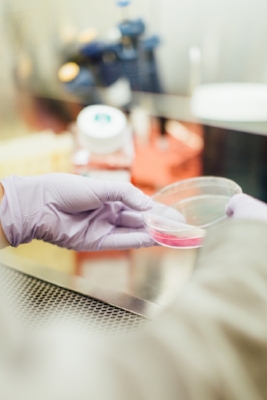When most people think of food allergies, they imagine hives, swelling, sore throats, and other serious symptoms that could lead to frightening and even fatal issues.
While these are certainly tell tale signs of an allergic reaction, not all the symptoms are so obvious. Food allergies can also be subtle and present through signs like headaches, scratchy throat, fatigue, stomach aches or cramps, diarrhea, rash, and other annoying but otherwise benign reactions. These more mild symptoms usually fall under a food intolerance rather than a full-blown allergy, but this doesn’t make them any less serious. If your body does not respond well to certain foods and you continue to consume them, you could be putting yourself and your health at risk.
Whether or not you’ve noticed any odd symptoms that don’t seem to be linked to anything, it’s always wise to test for food allergies. This way you know what foods to steer clear of to keep feeling your absolute best.
What is Food Allergy Testing?
Over 15 million people in the United States have some type of food allergy but they are unaware of it. There are various types of allergies, and you may not know that you’re having an allergic reaction when one occurs.
Due to this, many people expose themselves to harm after consuming or being around allergens they don’t know they have a sensitivity to. With this in mind, getting a food allergy test done just makes sense, and it’s never been easier to do so.
Food allergy testing is a simple procedure and offers fairly accurate feedback that is easy to understand. This highlights what foods trigger reactions in your body using a combination of detailed medical history and food allergy testing itself.
What to Expect from Food Allergy Testing
One important thing to remember about food allergy testing as noted by the Mayo Clinic is that there really is no “perfect test” to determine whether or not you have a food allergy. Food allergy research and education has yielded many new findings on food allergies and sensitivities, but pinpointing an actual diagnosis depends solely on testing and other factors to make a judgement as accurate as possible.
When it comes to food allergy testing itself, then, the following tests are most commonly used:
Types of Food Allergy Tests
Skin Test: Also known as a skin prick test, this test is done to determine your body’s reaction to particular foods. This test is performed by taking a small amount of the food you may have an allergy towards and placing it on the skin of your back or forearm. Following this step, your health professional will prick your skin with a fine needle to allow the smallest possible amount of the food beneath the surface of your skin. If a raised bump like a mosquito bite or similar small reaction occur, it could indicate that you are allergic to that food. However, having a reaction to this test is not enough to fully diagnose an allergy, which is your doctor may have you do an additional test before confirming.
Blood Test: Perhaps the most accurate type of food allergy testing, the blood test measures your immune system’s response to certain foods by measuring immunoglobulin (IgE), which is an allergy-related antibody. The test is done like any other blood test in which small vials of blood samples are taken to undergo different tests. Once you have finished giving blood, the samples are sent to the lab where different foods are tested.
Elimination Diet: The elimination diet takes some time because it involves removing certain foods from your daily diet for a week or two and monitoring how you feel. After that, you add these foods back into your diet one at a time and watch and see if certain symptoms reappear. This way your doctor can link certain signs and symptoms to specific foods, ruling out which ones are causing allergic reactions and which are not. Of course, the elimination diet is not perfect but is done early on to offer insights into your suspect symptoms.
Oral Food Challenge: The oral food challenge is conducted in your doctor’s office to help keep you safe and fully monitored at all times. As the name indicates, this test is done by giving you small but gradually increasing amounts of foods you suspect are causing allergy-like symptoms. If the food(s) in question do not give you a reaction during this test, you are likely safe to eat it without incident.
Are There Any Side Effects to Watch Out For?
Food allergy testing is pretty safe overall, but, like with all medical procedures, there is a margin for risk. The most common side effects are benign reactions, like itching and skin swelling, but there is still a chance for more serious reactions to show up.
With this in mind, having the tests conducted in your doctor’s office with medical professionals is the safest way to do things. Overall, the risk of side effects is very low.
What is the Best Testing Method?
The different tests have their own merits, meaning that one does not necessarily stand out from the others. The skin prick test is one of the more popular tests because it gives quick results and usually is more cost-effective than a blood test. Of course, there are some drawbacks to this test, especially if you have a fear or sensitivity to needles. For best results, only a highly trained specialist should conduct a skin prick test.
On the other hand, a blood test is helpful because it is usually more accurate than other tests. Blood tests only involve a single needle prick and are done quickly. What’s more, you can return to your normal day after a blood test and medication won’t interfere with your results. The main drawback lies in the cost of a blood test and the risk of false positives.
What to Do With the Information Now That You Have It
When food allergy testing is done and the results are in, what do you do next?
First, it is important to remember that results may not always be 100% accurate, so avoid any foods that pose potential risk to your health. Being careful and mindful is the next step, meaning it is up to you to put the information you’ve gotten to good use. Ask about allergy information when trying new restaurants, cut out suspect foods from your diet completely, and keep track of what you eat in general. When you’re conscious of what you put into your body, you are more aware of patterns when you begin to feel poorly after you eat specific foods.
For more severe reactions, your doctor should give you an EpiPen, which is a device that administers medication when your body needs immediate response to an allergic reaction. Remember to keep your doctor and an emergency number on your phone at all times, should the worst happen.
All in all, undergoing food allergy testing is a smart step to avoid health issues down the road. When you know what food may cause you harm, you can work to avoid them and exclude them for your diet.












Keto, or the Ketogenic Diet, is known for being a low carb diet, high-fat diet geared toward producing high levels of energy and stamina.